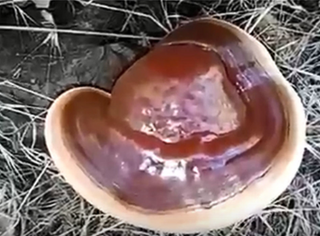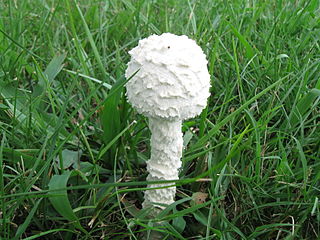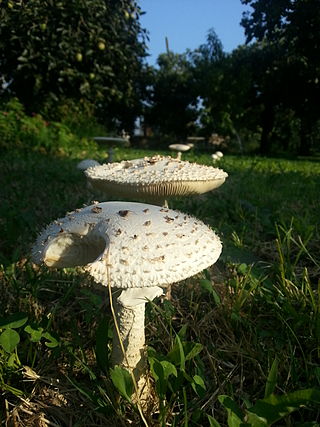
The Polyporales are an order of about 1800 species of fungi in the division Basidiomycota. The order includes some polypores as well as many corticioid fungi and a few agarics. Many species within the order are saprotrophic, most of them wood-rotters. Some genera, such as Ganoderma and Fomes, contain species that attack living tissues and then continue to degrade the wood of their dead hosts. Those of economic importance include several important pathogens of trees and a few species that cause damage by rotting structural timber. Some of the Polyporales are commercially cultivated and marketed for use as food items or in traditional Chinese medicine.

The Agaricales are an order of fungi in the division Basidiomycota. As originally conceived, the order contained all the agarics, but subsequent research has shown that not all agarics are closely related and some belong in other orders, such as the Russulales and Boletales. Conversely, DNA research has also shown that many non-agarics, including some of the clavarioid fungi and gasteroid fungi belong within the Agaricales. The order has 46 extant families, more than 400 genera, and over 25,000 described species, along with six extinct genera known only from the fossil record. Species in the Agaricales range from the familiar Agaricus bisporus and the deadly Amanita virosa to the coral-like Clavaria zollingeri and bracket-like Fistulina hepatica.

Amphizoa is a genus of aquatic beetles in the suborder Adephaga, placed in its own monogeneric family, Amphizoidae. There are five known species of Amphizoa, three in western North America and two in the eastern Palearctic. They are sometimes referred to by the common name troutstream beetles.

Ganoderma lucidum is a red-colored species of Ganoderma with a limited distribution in Europe and parts of China, where it grows on decaying hardwood trees. Wild populations have been found in the United States in California and Utah but were likely introduced anthropogenically and naturalized.

The Clavariaceae are a family of fungi in the order Agaricales. Originally the family contained most of the clavarioid fungi, but in its current sense is more restricted, albeit with a greater diversity of basidiocarp forms. Basidiocarps are variously clavarioid or agaricoid (mushroom-shaped), less commonly corticioid or hydnoid.

Ganoderma is a genus of polypore fungi in the family Ganodermataceae that includes about 80 species, many from tropical regions. They have a high genetic diversity and are used in traditional Asian medicines. Ganoderma can be differentiated from other polypores because they have a double-walled basidiospore. They may be called shelf mushrooms or bracket fungi.
Hyphomycetes are a form classification of fungi, part of what has often been referred to as fungi imperfecti, Deuteromycota, or anamorphic fungi. Hyphomycetes lack closed fruit bodies, and are often referred to as moulds. Most hyphomycetes are now assigned to the Ascomycota, on the basis of genetic connections made by life-cycle studies or by phylogenetic analysis of DNA sequences; many remain unassigned phylogenetically.

The Hyaloriaceae are a family of fungi in the order Auriculariales. Species within the family have gelatinous basidiocarps that produce spores on septate basidia and, as such, were formerly referred to the "heterobasidiomycetes" or "jelly fungi". All appear to be saprotrophic, growing on dead wood or plant remains. Less than 30 species are currently included within the Hyaloriaceae, but the family has not been extensively researched.

Morchella elata is a species of fungus in the family Morchellaceae. It is one of many related species commonly known as black morels, and until 2012 the name M. elata was broadly applied to black morels throughout the globe. Like most members of the genus, M. elata is a popular edible fungus and is sought by many mushroom hunters.
Episphaeria is a genus of fungus in the Agaricales. The genus is monotypic, and contains the single rare species Episphaeria fraxinicola, found in Europe. Its familial position is not known with certainty. The tiny fruit bodies of the fungus resemble minute, white cups that grow scattered or in groups on the bark of ash trees.

The clavarioid fungi are a group of fungi in the Basidiomycota typically having erect, simple or branched basidiocarps that are formed on the ground, on decaying vegetation, or on dead wood. They are colloquially called club fungi and coral fungi.

Saproamanita thiersii, commonly called Thiers' lepidella, is a North American saprotrophic basidiomycete fungus in the genus Saproamanita. It is a white, small mushroom. Its cap is convex, measuring 3.5–10 centimetres across, and the stipe is 8–20 cm (3–8 in) long. The spore print is white.
Penicillium coffeae is a fungus species of the genus of Penicillium which was isolated from the plant Coffea arabica L. in Hawaii. Insects play a role in spreading Penicillium coffeae.
Penicillium decaturense is a species of the genus of Penicillium which was isolated from a fungus in North America. Penicillium decaturense produces citrinin, 15-Deoxyoxalicine B, decaturins A and decaturins A
Penicillium psychrosexualis is a filamentous fungus in the genus Penicillium. Described as new to science in 2010, the species was found growing on refrigerated moldy apples in the Netherlands. It is closely related to the blue cheese fungus P. roqueforti.
Penicillium thiersii is a species of fungus in the genus Penicillium which was isolated from a wood decay fungi (Hypoxylon) in Wisconsin in North America. Penicillium thiersii produces thiersindole A, thiersindole B, thiersindole C, oxalicine A and oxalicine B

The genus Saproamanita contains about 24 species of agarics and is one of six genera in the family Amanitaceae, of which the similar Amanita is also a member. Saproamanita differs from Amanita in that its species are saprophytic, and not ectomycorrhizal.

Fungal DNA barcoding is the process of identifying species of the biological kingdom Fungi through the amplification and sequencing of specific DNA sequences and their comparison with sequences deposited in a DNA barcode database such as the ISHAM reference database, or the Barcode of Life Data System (BOLD). In this attempt, DNA barcoding relies on universal genes that are ideally present in all fungi with the same degree of sequence variation. The interspecific variation, i.e., the variation between species, in the chosen DNA barcode gene should exceed the intraspecific (within-species) variation.
Tremella yokohamensis is a species of fungus in the family Tremellaceae. It produces white, foliaceous, gelatinous basidiocarps and is parasitic on other fungi on dead wood of broad-leaved trees. It was originally described from Japan.











